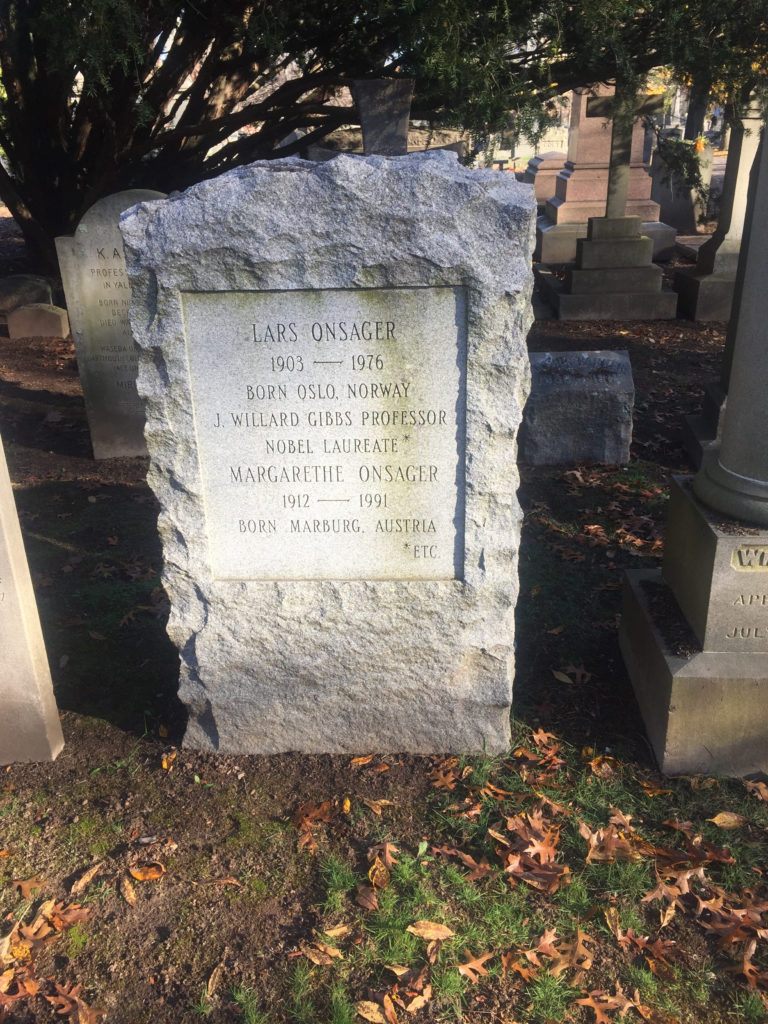Erik Visits an American Grave, Part 836
This is the grave of Lars Onsager.

Born in Oslo, Norway in 1903, Onsager grew up well-off, the son of a prominent lawyer. He went to college at the Norwegian Institute of Technology in Trondheim, graduating in 1925 with a degree in chemical engineering. He was a bit of a prodigy. Just as he graduated, he decided that something called the Debye–Hückel equation was wrong. Now, I am no chemist…lord knows…so bear with my attempts to explain things the rest of this post. Actually, forget it, I am just going to quote Wikipedia here. Sue me.
The chemists Peter Debye and Erich Hückel noticed that solutions that contain ionic solutes do not behave ideally even at very low concentrations. So, while the concentration of the solutes is fundamental to the calculation of the dynamics of a solution, they theorized that an extra factor that they termed gamma is necessary to the calculation of the activity coefficients of the solution. Hence they developed the Debye–Hückel equation and Debye–Hückel limiting law. The activity is only proportional to the concentration and is altered by a factor known as the activity coefficient γ {\displaystyle \gamma }
. This factor takes into account the interaction energy of ions in solution.
Well, whatever that means, Onsager went to Debye and told him he was wrong and published a paper in 1926 to say so. Debye was not offended. He was quite impressed with this precocious young scientist. So he did what any smart person would do in this situation: he hired Onsager as his assistant.
In 1928, Johns Hopkins brought Onsager over. But there was one problem. Onsager may have been a genius. But he was a horrible teacher. He had to teach freshman chemistry. He was so bad at this that he was fired after one semester. Brown hired him next, hoping that he could teach higher-level students. Nope. He was just completely incapable of teaching at all. He couldn’t teach graduate students either. But it was Brown and who really cares about teaching in the Ivies? They didn’t fire him. They just had him do research. In 1933, Yale hired him as a postdoctoral fellow. One problem–he did not have a Ph.D. So he just threw together some research there and Yale gave it to him. They hired him as an assistant professor in 1934 and in a place where they really didn’t care about teaching, he would remain there.
Anyway, teaching snark aside, Onsager was a brilliant scientist. I’m not even going to pretend at this point that I understand any of it. His work led to the Onsager reciprocal relations in thermodynamics that made little sensation at the time, but after World War II helped to shape the field. His theoretical chemistry applied advanced mathematics to the field. His work included everything from the superfluid properties of liquid helium to the magnetic properties of metals. For all of this, Onsager won the Nobel Prize in Chemistry in 1968. He won all sorts of medals and prizes. After he retired in 1972, he went to Miami and started an institute at the University of Miami, which I assume had the advantage of being old in Florida, which seems to be a universal desire of the old in America. He died of a brain aneurysm in 1976. He was 72 years old.
Lars Onsager is buried in Grove Street Cemetery, New Haven, Connecticut.
If you would like this series to completely butcher other Nobel Prize winning chemists’ biographies, you can donate to cover the required expenses here. Robert Mulliken, who won the Nobel in 1966, is in Chicago and Robert Burns Woodward, won won in 1965, is in Cambridge, Massachusetts. Previous posts in this series are archived here.


